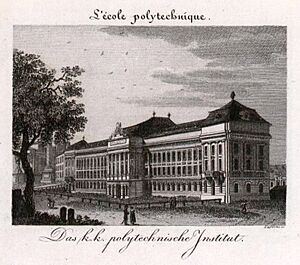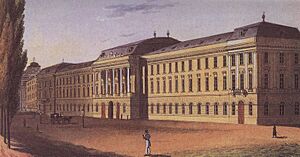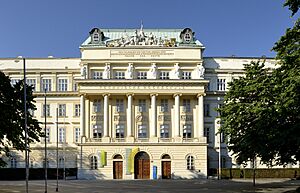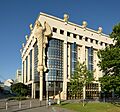TU Wien facts for kids
|
Technische Universität Wien
|
|
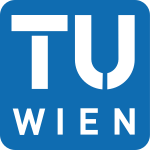 |
|
| Motto |
Technik für Menschen
|
|---|---|
|
Motto in English
|
Technology for people |
| Type | Public |
| Established | November 6, 1815 |
| Founder | Emperor Francis I of Austria |
| Affiliation |
|
| Budget | €271 million (2019) |
| Rector | Jens Schneider |
|
Academic staff
|
4,228 (2020) |
|
Administrative staff
|
1,271 (2020) |
| Students | 26,654 (2021) |
| Location |
,
Austria
|
| Campus | Urban |
 |
|
TU Wien, also known as the Vienna University of Technology, is a big public university in Vienna, Austria. Its full name in German is Technische Universität Wien.
This university is a place where students learn and researchers discover new things. They focus on subjects like engineering, computer science, and different kinds of science. About 28,100 students attend TU Wien, and around 5,000 people work there.
Contents
History of TU Wien
How the University Started
The university was first opened in 1815. It was started by Emperor Francis I of Austria. Back then, it was called the Imperial-Royal Polytechnic Institute. The first leader of the university was Johann Joseph von Prechtl.
Changes to the Name
Over the years, the university's name changed a few times. In 1872, it became known as the Technical College. Then, in 1975, it was given its current name, Technische Universität Wien, or TU Wien for short.
What TU Wien is Known For
A Top Technology University
TU Wien is a well-known university for technology. It explores many scientific ideas. This includes basic research, which is about understanding how things work. It also includes applied research, which means using science to solve real-world problems. The university often works with companies and other research places.
University Rankings
TU Wien is considered one of the best universities in the world. It is often ranked highly for its engineering and computer science programs. For example, it has been placed among the top 100 universities globally for computer science by some important ranking groups. This shows that TU Wien is a great place to study these subjects.
How TU Wien is Organized
The Faculties
TU Wien has eight main departments, called faculties. Each faculty is led by a dean. These faculties cover many different areas, such as:
- Architecture and Planning
- Chemistry
- Civil Engineering
- Computer Sciences
- Electrical Engineering and Information Technology
- Mathematics and Geoinformation
- Mechanical and Industrial Engineering
- Physics
How the University is Run
The university is led by a Rector and four Vice Rectors. These leaders are in charge of things like research, student affairs, money, and staff. There is also a Senate with 26 members. A University Council, made up of seven members, helps to oversee everything.
Research and Discoveries
Exploring New Ideas
At TU Wien, people work on new ideas in almost all areas of technology. They combine basic science with different types of engineering. This helps them to develop new solutions and inventions. The university also works with other universities, research centers, and businesses on many projects.
Main Research Areas
TU Wien focuses on several important research areas. These include:
- Computational science and engineering (using computers to solve problems)
- Quantum physics and quantum technologies (studying tiny particles and new technologies)
- Materials and matter (learning about different substances)
- Information and communication technology (how we use computers and communicate)
- Energy and environment (finding new ways to get energy and protect our planet)
The university also has a special team that helps researchers get funding for their projects, especially from the European Union.
Famous People from TU Wien
Many talented people have studied or taught at TU Wien. Here are a few examples:
- Christian Andreas Doppler (1803–1853), an Austrian mathematician and physicist. He discovered the Doppler effect, which explains how waves (like sound or light) change as their source moves.
- Viktor Kaplan (1876–1934), an inventor who created the Kaplan turbine. This is a special type of water turbine used to generate electricity.
- Alexander Meissner (1883 – 1958), an Austrian engineer and physicist. He helped invent the Electronic oscillator, which is important for radio and other electronic devices.
- Paul Eisler (1907–1992), who invented the printed circuit. This invention is a key part of almost all electronic devices today.
- Ingeborg Hochmair (born 1953), an electrical engineer. She helped develop the first microelectronic, multi-channel cochlear implant, which helps people with hearing loss.
- Ferenc Krausz (born 1962), a Hungarian-Austrian physicist. He won the Nobel Prize in Physics in 2023 for his work with very short light pulses.
- Elfriede Tungl (1922-1981), a civil engineer. She was the first Austrian woman to earn a doctorate in civil engineering and became the first female associate professor at TU Wien in 1973.
- Ina Wagner (born 1946), an Austrian physicist and sociologist. She became TU Wien's second female professor in 1987.
University Library
The TU Wien Library was started in 1815, the same year the university opened. The main library building was finished in 1987. It has six floors where students can find books and study. There are about 700 desks for students to use. You can even see cool owl sculptures by the artist Bruno Weber there!
Sports at TU Wien
In October 2007, TU Wien hosted the IFIUS World Interuniversity Games. This was a big sports event for university students from all over the world.
Images for kids
See also
 In Spanish: Universidad Técnica de Viena para niños
In Spanish: Universidad Técnica de Viena para niños
- TU Austria


